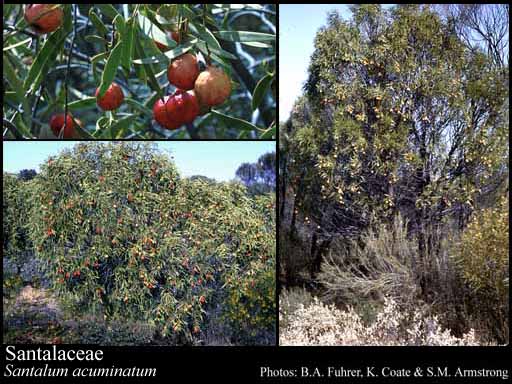- Reference
- Prodr.Fl.Nov.Holland. 350 (1810)
- Name Status
- Current

Scientific Description
Common name. Sandalwood Family.
Habit and leaf form. Trees, shrubs, and herbs. More or less ‘normal’ plants, or switch-plants; sometimes with the principal photosynthesizing function transferred to stems. Leaves well developed, or much reduced. Plants with roots, or rootless; partially parasitic. On roots of the host, or on aerial parts of the host. Mesophytic, or xerophytic. Leaves opposite (usually), or alternate; ‘herbaceous’, or leathery, or fleshy, or membranous, or modified into spines; petiolate to sessile; gland-dotted, or not gland-dotted; aromatic, or without marked odour; simple; pulvinate. Leaf blades entire; one-veined, or pinnately veined. Leaves without stipules. Stem anatomy. Nodes unilacunar. Secondary thickening developing from a conventional cambial ring.
Reproductive type, pollination. Fertile flowers hermaphrodite, or functionally male and functionally female, or functionally male, or functionally female. Unisexual flowers present, or absent. Plants hermaphrodite, or monoecious, or dioecious.
Inflorescence and flower features. Flowers solitary, or aggregated in ‘inflorescences’; in cymes, or in racemes, or in spikes, or in heads, or in fascicles. The terminal inflorescence unit cymose, or racemose. Inflorescences terminal, or axillary; variously spikes, racemes or heads, the flowers solitary in the bract axils or forming cymes of three. Flowers bracteate; small; regular; (3–)4–5(–8) merous; cyclic; tricyclic. Free hypanthium present, or absent. Perianth sepaline, or petaline (dubiously, then perhaps sepaline-petaloid); (3–)4–5(–8); 1 -whorled; free, or joined (the lobes valvate); sepaloid, or petaloid; green, or white, or cream, or yellow, or red; fleshy, or non-fleshy; persistent, or deciduous. Calyx (‘calycode’) (3–)4–5(–8); 1 -whorled; gamosepalous; valvate; regular; fleshy, or non-fleshy; persistent, or not persistent. Fertile stamens present, or absent (female flowers). Androecium (3–)4–5(–8). Androecial members free of the perianth (attached at its base), or adnate (to the middle of the lobes); all equal; free of one another; 1 -whorled. Androecium exclusively of fertile stamens. Stamens (3–)4–5(–8); isomerous with the perianth; oppositisepalous. Anthers dorsifixed, or basifixed; dehiscing via pores, or dehiscing via short slits to dehiscing via longitudinal slits; introrse; bilocular, or four locular (Choretrum); tetrasporangiate. Fertile gynoecium present, or absent (male flowers). Gynoecium (2–)3(–5) carpelled. The pistil 1 celled. Carpels reduced in number relative to the perianth to isomerous with the perianth. Gynoecium syncarpous; synstylovarious, or eu-syncarpous; partly inferior to inferior. Ovary unilocular; 1 locular (at least above). Epigynous disk commonly present. Gynoecium non-stylate, or stylate. Styles 1; apical. Stigmas 1; capitate (or lobed). Placentation basal, or free central. Ovules differentiated to not differentiated; in the single cavity 1–3(–4); pendulous; hemianatropous to anatropous.
Fruit and seed features. Fruit fleshy, or non-fleshy; indehiscent; a drupe, or a nut; 1 seeded. Seeds endospermic. Endosperm oily, or not oily. Seeds without a testa. Cotyledons 2. Embryo achlorophyllous (Thesium linifolium). Seedling. Germination phanerocotylar, or cryptocotylar.
Physiology, biochemistry. Photosynthetic pathway: C3.
Geography, cytology, number of species. World distribution: cosmopolitan, except in cold regions. X = 5–7, 12, 13 (or more). 400 species.
Economic uses, etc. Some produce edible fruit, and Santalum album is the source of timber and perfume (sandalwood/sandalwood oil).
Keys
Western Australian Genera and Families of Flowering Plants — an interactive key
T.D. Macfarlane, L. Watson, N.G. Marchant